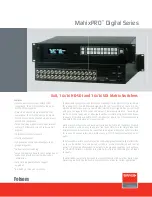
Chapter 1
Introduction
RUGGEDCOM RST2228
Installation Guide
4
Required Tools and Materials
LED
State
Description
Off
No active alarm conditions exist
Solid
The power source is supplying power to the device
PS1/PS2
Off
The power source is not supplying power to the device
USB Console Port
The serial console port is for interfacing directly with the device and accessing initial
management functions. For information about connecting to the device via the serial
console port, refer to
Section 3.1, “Connecting to the Device”
Alarm Indicator LED
The alarm indicator LED illuminates when an alarm condition exists. Pressing the Alarm Cut-
Off (ACO) button clears the alarm(s).
Removable Media
The device features sockets for up to four SFP/SFP+ transceivers and slots for up to six
removable media modules. For more information, refer to
.
Failsafe Alarm Relay
Latches to default state when a power disruption or other alarm condition occurs. For more
information, refer to:
•
Section 2.4, “Connecting the Failsafe Alarm Relay”
•
Section 5.2, “Failsafe Alarm Relay Specifications”
Power Supply Terminal Block
A pluggable terminal block. For more information, refer to:
•
Section 2.5, “Connecting Power”
•
Section 5.1, “Power Supply Specifications”
Chassis Ground Terminal
Protects the device from power surges and accumulated static electricity. For information
about grounding the device, refer to
Section 2.5, “Connecting Power”
Section 1.3
Required Tools and Materials
The following tools and materials are required to install the RUGGEDCOM RST2228:
Tools/Materials
Purpose
AC/DC power cord
For connecting power to the device. For the required. To determine
the proper wire gage, refer to
.
Lightning protector
For protecting the device from harmful electrical strikes.
Flathead screwdriver
For removing or installing modules and terminal blocks.
Torx T10 screwdriver
For removing or installing modules.
Phillips screwdriver
For removing or installing terminal blocks.
8 x M6 or #10-32 screws
For mounting the device to a panel.
8 x M6 or #10-32 screws
For mounting the device to a rack.
Braided or equivalent ground wire
For grounding the device to safety Earth.











































